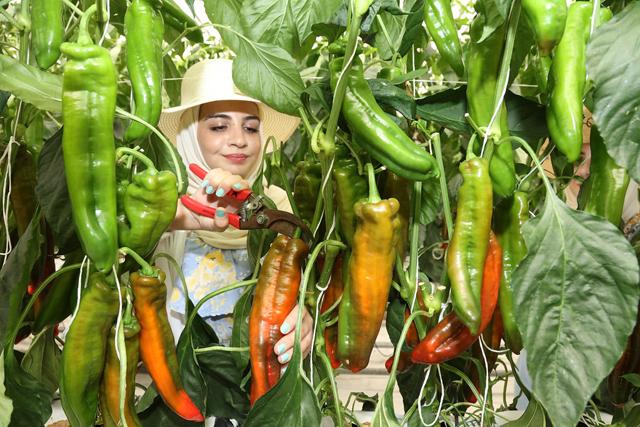You are here
Sahara Forest Project produces 220 tonnes of vegetables in demonstration phase
By Rayya Al Muheisen - May 15,2022 - Last updated at May 15,2022

The Sahara Forest Project’s ‘She Grows’ programme aims to empower women and increase employment opportunities by focusing on the skills required in the labour market (Photo courtesy of SFP)
AMMAN — The Sahara Forest Project (SFP) that envisages re-vegetation of the Jordanian desert with the use of sustainable technologies has produced 220 tonnes of vegetables since its 2017 launch, according to its managing director Kjetil Stake.
The 30-dunum Sahara Forest Project Launch Station, located outside the port city of Aqaba is mostly financed by Norway and the EU.
The project aims to green desert areas and to create local green jobs through the production of food, freshwater and clean energy, using saltwater and sunlight as the main input factors.
Stake said that almost 300kg of produce has been exported to Norway to test the delivery process as well as the logistics required for exporting produce to Europe.
“I am impressed with how the project’s innovative use of technologies is responding to Jordan’s water, energy and climate change challenges,” Norway’s Ambassador to Jordan Espen Lindbæck told The Jordan Times. “Our aim is to expand and become a key exporter to Europe,” he added.
Stake noted that the project is still in the demonstration phase, adding that the foundation intends to expand locally and scale up in order to make an impact and to be more economically sustainable.
However, a private pipeline is among key infrastructure needed for expansion, Stake said. “The project relies solely on solar energy,” he added.
He said that the project uses seawater and solar energy to produce vegetables, which could boost the Kingdom’s ability to achieve food security and demonstrate a viable green economy solution.
“The produce is distributed to local hotels and sold at the local market in Aqaba,” he noted.
He also noted that the SFP offers the “She Grows” programme, implemented with Al Hussein Technical University (HTU) and funded by the Norwegian embassy in Jordan.
“Fifty women have completed the programme so far,” he said.
According to the ambassador, “She Grows” aims to empower women and increase employment opportunities by focusing on the skills required in the labour market, such as climate smart agriculture and communication skills.
Skate said that “She Grows” is a technical training programme provided to young Jordanian women. The programme trains female engineering graduates on climate-smart practices as well as modern agricultural technologies. The programme aims to help fresh graduates prepare for their career.
He stated that “She Grows” is one of the strategic pillars of the SFP and resembles its social impact arm aiming to enhance women’s participation in the agriculture sector.
“The SFP site in Aqaba was recognised as a case study in the Intergovernmental Panel on Climate Change (IPCC) report,” he noted.
He added that the IPCC has acknowledged the SFP as “a solution for the future” in combating climate change and tackling water, food and energy security.
“Jordan is one of the countries in the world that experiences the harsh consequences of climate change and the increase in desertification,” according to the SFP website.
The Sahara Forest Project will make electricity generation from solar power more efficient, facilitate the operation of energy and water efficient salt water cooled greenhouses for growing high-value crops in the desert, produce freshwater for irrigation and drinking, safely manage brine and harvest useful compounds from the resulting salt.
Additionally, it will grow biomass for energy purposes without competing with food cultivation, and re-vegetate desert lands. The synergies arising from integrating the technologies improve performance and economics compared to those of the individual components, according to the website.
Related Articles
AMMAN — One year after the state visit of King Harald and Queen Sonja of Norway to Jordan, Jordanian vegetables are grown in the arid lands
AMMAN — The Sahara Forest Project (SFP), Bellona Foundation and Ernst & Young (EY) signed a new partnership agreement during the London
AMMAN — Costa Group, through its Costa Crociere Foundation, signed an agreement with the Sahara Forest Project Foundation to join forces to












